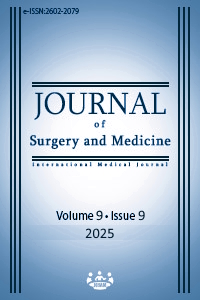A rare manifestation of Ewing sarcoma: Primary intracranial Ewing sarcoma
Primary intracranial Ewing sarcoma
Keywords:
Ewing sarcoma, primary intracranial Ewing sarcoma, dura invasion, muscle invasion, bone invasionAbstract
Primary intracranial Ewing sarcoma (ES) is an extremely rare condition, frequently presenting as supratentorial and intraparenchymal. This case report presents a 22-year-old male diagnosed with primary intracranial ES exhibiting dura, muscle, and bone invasion. The patient initially presented with swelling in the preauricular region and was operated on with a preliminary diagnosis of meningioma, but pathology confirmed primary intracranial ES. This case highlights the rarity of primary intracranial ES and provides significant contributions to the diagnostic process.
Downloads
References
Lin PP, Wang Y, Lozano G. Mesenchymal Stem Cells and the Origin of Ewing’s Sarcoma. Sarcoma. 2011;2011:276463. DOI: https://doi.org/10.1155/2011/276463
Applebaum MA, Worch J, Matthay KK, Goldsby R, Neuhaus J, West DC, et al. Clinical features and outcomes in patients with extraskeletal Ewing sarcoma. Cancer. 2011;117:3027-32. DOI: https://doi.org/10.1002/cncr.25840
Yu L, Craver R, Baliga M, et al. Isolated CNS involvement in Ewing’s sarcoma. Med Pediatr Oncol 1990;18:354-8. DOI: https://doi.org/10.1002/mpo.2950180503
Mendes WL, Osorio C, de Camargo B, Machado AB. Isolated CNS involvement in Ewing sarcoma. Med Pediatr Oncol. 1999;32:469-70. DOI: https://doi.org/10.1002/(SICI)1096-911X(199906)32:6<469::AID-MPO21>3.0.CO;2-W
Louis DN, Perry A, Wesseling P, Brat DJ, Cree IA, Figarella-Branger D, et al. The 2021 WHO Classification of Tumors of the Central Nervous System: a summary. Neuro Oncol. 2021;23:1231-51. DOI: https://doi.org/10.1093/neuonc/noab106
Jaffe N. Advances in the management of malignant bone tumors in children and adolescents. Pediatr Clin N Am 1985;32:801-10. DOI: https://doi.org/10.1016/S0031-3955(16)34837-4
Paulus W, Slowik F,Jellinger K. Primary intracranial sarcomas: Histopathological features of 19 cases. Histopathology 1991;18:395-402. DOI: https://doi.org/10.1111/j.1365-2559.1991.tb00869.x
Chen J, Jiang Q, Zhang Y, Yu Y, Zheng Y, Chen J, et al. Clinical features and long-term outcome of primary intracranial Ewing sarcoma/peripheral primitive neuroectodermal tumors: 14 cases from a single in- stitution. World Neurosurg 2019;122:e1606-14. DOI: https://doi.org/10.1016/j.wneu.2018.11.151
Cherif El Asri A, Benzagmout M, Chakour K, Chaoui MF, Laaguili J, Chahdi H, et al. Primary intracranial pPNET/Ewing sarcoma: diagnosis, management, and prognostic factors dilemma–a systematic review of the literature. World Neurosurg 2018;115:346-56. DOI: https://doi.org/10.1016/j.wneu.2018.04.164
Jiang Y, Zhao L, Wang Y, Liu X, Wu X, Li Y. Primary Intracranial Ewing Sarcoma/Peripheral Primitive Neuroectodermal Tumor Mimicking Meningioma: A Case Report and Literature Review. Front Oncol. 2020;6;10:528073. DOI: https://doi.org/10.3389/fonc.2020.528073
Kim HJ, Kim JH, Park KJ, Park DH, Kang SH. Primary Intracranial Ewing Sarcoma With an Unusual Presentation: A Case Report. Brain Tumor Res Treat. 2024;12:115-20. DOI: https://doi.org/10.14791/btrt.2024.0003
Jing Z, Wen-Yi L, Jian-Li L, Jun-Lin Z, Chi D. The imaging features of meningeal Ewing sarcoma/peripheral primitive neuroectodermal tumours (pPNETS). Br J Radiol 2014;87:20130631. DOI: https://doi.org/10.1259/bjr.20130631
Downloads
- 439 388
Published
Issue
Section
How to Cite
License
Copyright (c) 2025 Eren Kıymaz, Ünal Özüm
This work is licensed under a Creative Commons Attribution-NonCommercial-NoDerivatives 4.0 International License.
















